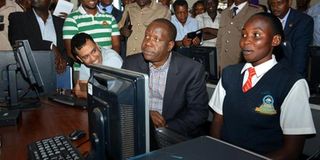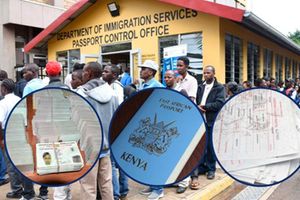ICT will drive the President’s service delivery revolution

Cabinet Secretary for ICT Fred Matiangi (centre) is taken through how Outernet works during its launch in Nakuru on March 9, 2015. PHOTO | SULEIMAN MBATIAH |
What you need to know:
- ICT, from the tea and pyrethrum fields of Nyamira to the entrepreneurial din of Nairobi’s streets, is creating change far and wide.
- Change is palpable in modern Kenya and, with ICT’s fingerprints characterising that momentum, it is serving as a magnet for international investors and globally renowned ICT brands.
- As the Cabinet Secretary for ICT, I know above everything else, that these decisions affect people.
As I looked on from the stage at Kenya’s first ICT Innovation Forum recently, an audience of 2,000 people ummed and ahhed, matching my quiet intrigue.
Within the theatre of the Kenyatta International Convention Centre (KICC), the co-creator of start-up CladLight, Charles Muchene, talked eloquently about his innovation, as a colleague-cum-boda boda driver wheeled out a motorcycle whilst clad in a reflective jacket with indicating LEDs, designed to reduce the number of accidents and deaths on the road.
I was fixated and mused to myself: technology has the power to do that; technology can save lives.
Just as Kenya’s innovators are working hard and quietly behind-the-scenes to create the Next Big Thing, so too has President Uhuru Kenyatta’s Jubilee manifesto embraced information and communications technology (ICT) to develop an enabling environment to help them do it.
To many Kenyans, the President’s digital revolution is already being felt: from the 15 million M-Pesa subscribers, previously excluded from formal financial services, to the suburban mother who can pay for power-on-demand with M-Kopa.
This change affects people, not things. It’s historical; in some cases life-changing.
But this is just a snapshot of change in the private sector, which is working in tandem with government to provide an ongoing, and relentless, approach to digital transformation.
TANGIBLE CHANGE
In generations to come, this could be the era in which a political legacy was not one defined by high-falutin statements, communicated via finely polished soundbites and soundpieces, but what was done. And it is being done with technology.
As any great explorer will tell you, though, the destination cannot be arrived at without a map.
Our government’s equivalent is the Jubilee manifesto and National ICT Master Plan, both in line with the national economic agenda, Vision 2030, which is helping to deliver tangible change.
One case in point is the digitalisation of e-Government services via the rollout of Huduma Centres. This is not merely about helping people, creating convenience or cutting interminable delays, though it plays a big part. Again: it’s about change, driven by ICT.
For the start-up entrepreneur, it means registering a single business permit; for the student, it means making a loan application and then having a clear location for repayments. For any citizen who wants a formal identity, it means ID cards.
These small nuances play a much larger role: fighting crime, corruption and terror - all watchwords of President Kenyatta’s vision.
Just like Muchene’s product, ICT is not really about machines and inanimate objects and post-modern creations. It’s about people. It’s about change. In Kenya today, that change is digital.
Allow me to spell out the how and the why of these changes.
In the implementation of nine key government ICT projects, we hope to tackle the existing shortage of vital skills needed to make the digital transition. While we want to evolve into a 21st Century government as soon as possible, we recognise that there are capacity issues.
The Presidential Digital Talent Programme (PDTP), launched last month, is one vehicle we are using to accelerate this drive. The PDTP has catapulted some 100 fresh university graduates from the classroom to the boardrooms of national government, providing a training ground and readying them to be the industry leaders and experts of the future.
Real life industry experience is vital to give our young people the best chance of success and, with the programme already showing positive indicators of what’s to come, the number of graduates on the PDTP could triple to 300 in the next financial year.
This will give young Kenyans an opportunity to make their mark and take ownership of our nation’s future. What it will also do is create up to 1,000 jobs in five years.
Just as ICT can be the tool to spark change, so will we need to harness existing resource sites such as universities, to create centres of excellence, where Kenyan businesses can source local, blooming talent and also test out innovations.
MIGRATION
Kenya is already showing the signs of 21st Century innovation in miniature: the proliferation of “M”-peppered digital breakthroughs, from M-Pesa to M-Kopa and others, demonstrates this.
This innovation, we hope, will become a byword associated with Kenya in the future and it is with the rollout of initiatives such as the PDTP that will encourage, inspire and instill hope in future generations.
And, in just a few months, on June 18, following the historic moment of the Digital Migration, when Kenya will bid farewell to analogue broadcasting and enter a new era of digitalisation, we will build an LTE (4G) network to allow Kenyans broader access to the internet.
Change is palpable in modern Kenya and, with ICT’s fingerprints characterising that momentum, it is serving as a magnet for international investors and globally renowned ICT brands.
The Jubilee Government’s recent support for Enterprise Kenya, which encapsulates our commitment to help ‘Build IT in Kenya, Buy IT in Kenya’, through the creation of an entity that will start, grow and help homegrown business people innovate and win export sales in international markets.
Some years from now, Kenyans — young and old — will look back on the heady days of a balmy March day at the KICC, when the wind of change quietly swept forth, and major decisions were taken to create a globally powerful export sector.
These are not just changes that add value or finesse, but can radically change your hamlet, village, town, city — and home. In some cases, the game-changing difference ICT is making is literally a matter of life and death.
More evidence of this is theSh38 billion Managed Equipment Services project, which will see medical equipment manufacturers install and oversee the management of machines, instigating mammoth changes that will be manifested in each of our 47 counties, as they will have two hospitals fully equipped with innovative, state-of-the-art facilities.
In practical terms, it means new digital X-ray machines, ultrasound and imaging equipment; it means modern theatre instruments, surgical, sterilisation and laboratory apparatus.
As the Cabinet Secretary for ICT, I know above everything else, that these decisions affect people.
This is what, united as a government, we committed to delivering on when the President was sworn in on April 9, 2013. With the ICT Master Plan guiding us, this Government predicts the ICT sector will contribute at least 8 per cent of our Gross Domestic Product; and create 55 ICT companies two of which will have a customer base of over 5 million.
Starting tomorrow hundreds of people will gather in the somewhat exotic surroundings of a beach resort in Mombasa. There will be academics, technologists, government officials, entrepreneurs, intrapreneurs — and C-suite executives.
But, above all else, there will be people just that little bit “crazy” who dare to dream and dare to believe that ICT can change the world around them. The Connected East Africa Summit this week will be the beginning of a necessary regional conversation on where we go next with building ICT networks across the region.
The writer is Kenya’s Cabinet Secretary for ICT





